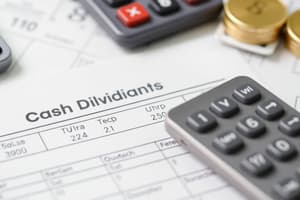Podcast
Questions and Answers
What is a potential disadvantage of paying dividends?
What is a potential disadvantage of paying dividends?
- Increases cash reserves for future projects
- Limits available funds for expansion and growth (correct)
- Indicates strong growth opportunities within the company
- Encourages long-term investment strategies
Which factor can affect how dividend income is taxed for an individual investor?
Which factor can affect how dividend income is taxed for an individual investor?
- The individual investor's tax bracket and jurisdiction (correct)
- The stock's annual return on equity
- The company's overall profit margin
- The level of competition in the investor's sector
How can a company’s dividend policy impact its stock price?
How can a company’s dividend policy impact its stock price?
- Dividends have no impact on stock price
- Stable dividends may boost investor confidence and stock prices (correct)
- High dividends always lead to lower stock prices
- Increased dividends automatically lead to lower market demand
Why might management choose to pay dividends despite potential downsides?
Why might management choose to pay dividends despite potential downsides?
Which of the following statements about dividend taxation is accurate?
Which of the following statements about dividend taxation is accurate?
What is the primary form in which dividends are commonly paid?
What is the primary form in which dividends are commonly paid?
Which date is critical for determining which shareholders are eligible for receiving dividends?
Which date is critical for determining which shareholders are eligible for receiving dividends?
How is dividend yield primarily calculated?
How is dividend yield primarily calculated?
Which of the following best describes a stock dividend?
Which of the following best describes a stock dividend?
What is a Dividend Reinvestment Plan (DRIP)?
What is a Dividend Reinvestment Plan (DRIP)?
Which entity is responsible for proposing a dividend declaration?
Which entity is responsible for proposing a dividend declaration?
Which of the following types of dividends involves payments made in assets other than cash?
Which of the following types of dividends involves payments made in assets other than cash?
What factor does NOT influence a company's decision to declare dividends?
What factor does NOT influence a company's decision to declare dividends?
Flashcards
Capital Expenditure Needs
Capital Expenditure Needs
The amount of money a company needs to invest in assets like property, equipment, and technology.
Tax Implication of Dividends
Tax Implication of Dividends
Dividend income is taxed at a lower rate than profits from selling shares.
Dividend Policy
Dividend Policy
Companies decide how much of their profits to pay out to shareholders as dividends.
Dividend Policy & Stock Price
Dividend Policy & Stock Price
Signup and view all the flashcards
Level of Debt & Dividends
Level of Debt & Dividends
Signup and view all the flashcards
What are dividends?
What are dividends?
Signup and view all the flashcards
What are cash dividends?
What are cash dividends?
Signup and view all the flashcards
What are stock dividends?
What are stock dividends?
Signup and view all the flashcards
What are property dividends?
What are property dividends?
Signup and view all the flashcards
What is dividend yield?
What is dividend yield?
Signup and view all the flashcards
What is a Dividend Reinvestment Plan (DRIP)?
What is a Dividend Reinvestment Plan (DRIP)?
Signup and view all the flashcards
What is the Dividend Declaration Date?
What is the Dividend Declaration Date?
Signup and view all the flashcards
What is the Record Date?
What is the Record Date?
Signup and view all the flashcards
Study Notes
Dividends: Basic Concepts
- Dividends are distributions of a company's profits to its shareholders.
- They represent a portion of the company's earnings paid to investors.
- Dividends are typically paid in cash, but can sometimes be issued as stock dividends.
- Companies often declare dividends at regular intervals, such as quarterly or annually.
Types of Dividends
- Cash Dividends: The most common type, where shareholders receive a certain amount of money per share.
- Stock Dividends: Companies issue additional shares of stock to shareholders instead of cash, increasing ownership percentage without cash outflow.
- Property Dividends: Payments in assets other than cash, like real estate or tangible goods.
Dividend Declaration Process
- Board of Directors: The board formally proposes the dividend declaration.
- Dividend Declaration Date: The date the board approves the dividend payment.
- Record Date: The date that determines eligible shareholders for the dividend payment.
- Payment Date: The date when dividends are disbursed to shareholders.
Dividend Payment Mechanics
- Shareholders eligible on the record date receive the dividend.
- Dividends can be paid in various forms, including checks, direct deposit, or company internal systems.
- Dividend reinvestment plans (DRIPs) allow automatic reinvestment of dividends to purchase more shares.
Dividend Yield
- Dividend yield measures a company's profitability, helping investors determine dividend return.
- Calculated by dividing annual dividend per share by stock price per share, expressed as a percentage.
- It assesses return on investment focusing solely on dividends.
- Higher yield generally suggests a greater payout.
Dividend Reinvestment Plan (DRIP)
- DRIPs allow investors to automatically reinvest dividends to purchase more company stock.
- Usually offered at a set price, maximizing shareholder returns.
- Often provides better pricing than other purchase methods, reducing per-share cost.
Factors Influencing Dividend Decisions
- Company's financial performance and profitability.
- Capital expenditure requirements.
- Industry norms and trends.
- Management's perception of future growth prospects.
- Tax considerations for both the company and shareholders.
- Level of debt, ensuring sufficient cash flow.
Tax Implications of Dividends
- Dividend income is typically taxed at a lower rate than capital gains.
- Tax implications vary by investor tax bracket and jurisdiction.
- Dividend types may have different tax treatments by jurisdiction.
Advantages & Disadvantages of Dividends
- Advantages:
- Provides income for shareholders.
- Signals company financial stability.
- Motivates investors.
- Disadvantages:
- May signal limited alternative profitable cash uses.
- Can reduce funds for expansion and growth.
- May result in lower capital gains than alternative investments.
Relationship with Stock Price
- A company's dividend policy influences stock price, though the precise impact is complex and debated.
- A stable dividend policy often builds investor confidence and higher stock prices.
- Regular and increasing dividend payments reflect strong financial performance, encouraging positive investment signals.
Studying That Suits You
Use AI to generate personalized quizzes and flashcards to suit your learning preferences.




